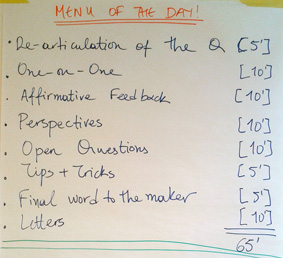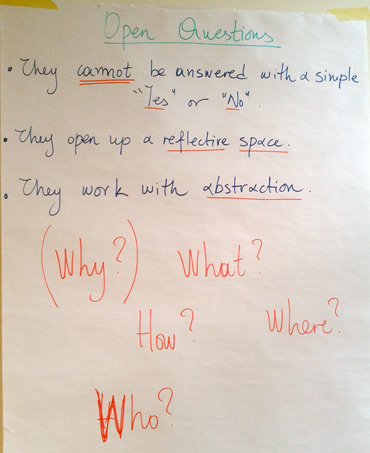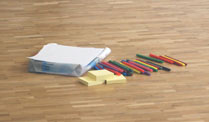| Learning from feedback
How does asking questions and being asked questions contribute to learning? There is an art and a practice to asking questions, and being aware of what you want to achieve with them. With the right kind of questions, feedback sessions contribute to group learning.
Before you formulate a question, ask yourself what you want to achieve with it. Are you genuinely interested in an answer? Does your question help the presenter? Is your question interesting for others in the group? Try to achieve the following:
Your question opens up a learning opportunity for |
|
Yourself |
The presenter |
1. The Presenter’s Question
The Presenter’s Question is is an invitation for feedback. What are we going to experience in your presentation? Is it a finished piece, a work-in-progress, or just an idea? What part of the work will we look at? What are the questions you have at the moment? What would you like to get feedback on? – Be ready to present this is in less than five minutes.
2. Affirmative Feedback
Feedback is usually associated with criticism, but we also want to learn from what works. This is different from giving the presenter a compliment. The aim is to communicate what worked for us. Start your Affirmative Feedback with “What worked for me is x”.
3. Perspectives Feedback
What perspective are you asking your question from? Are you reacting to what you’ve just heard and seen as an audience member, as a peer, as a friend, as a journalist, as a fellow German? Make clear what your most important need is from this perspective. Start your Perspectives Feedback with “From the perspective of a ... , I need ... ”.
From the perspective of a .... |
I need …
|
4. Open Questions
Closed questions can be answered by a “yes” or a “no”. Closed Questions guide the answer in a certain direction: “did his refusal make you really angry?” Open questions give as much space as possible. Start open questions with “why”, “how”, “who”, “when”, “what”. For example: “What did you do?” “Why did you use this effect?” “How did this make you feel?” Open question may seem simple, but they are very powerful. Open Questions open up space for divergent thinking, and are thus more suited for initial ideas or work-in-progress than for finished work.
5. Concept Reflection
In order to open the reflective space of the person whose work you are questioning, come up with a concept to start their thinking process. This concept should start a series of associations that help the presenter think about their work in a way that is productive for them. The concept could be a single word or a short expression. Examples: “How does your work relate to time?” “What role does home play in your piece?” “What is explicit in your work?”
6. Gossip
Gossip is a group discussion; everyone can speak freely, as if the presenter was not there. The presenter listens attentively without reacting. A gossip session allows views to be aired for which there is no space in the more regulated forms of feedback.
7. Tips & Tricks
Tips & tricks are bits of practical advice that will help the presenter. These can include technical advice, ideas for the piece, recommendations for further reading or references to other artists. Make sure the advice is practical and helpful rather than critical and general.
8. Personal Letter
It is very useful to conclude a feedback session with a Personal Letter to the presenter. Everyone takes five minutes to write down a personal message. This can include things that were not mentioned in the session or personal anecdotes. It also serves as a personal reflection for the people giving feedback, and concludes the session in silence.
Handout von Karim Bennamar, Einführungstag an der Hochschule der Künste Bern, Dezember 2012. |
 Abb. 4)
Abb. 4) Abb. 4)
Abb. 4) Abb. 3)
Abb. 3) Abb. 7)
Abb. 7)




 Abb. 6)
Abb. 6)

